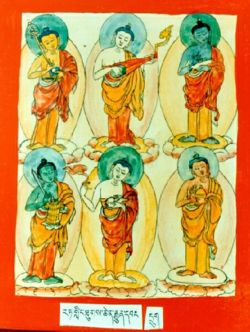Six Munis: Difference between revisions
Jump to navigation
Jump to search
mNo edit summary |
(ISBN.) |
||
| Line 13: | Line 13: | ||
==Further Reading== | ==Further Reading== | ||
*[[Dudjom Rinpoche]], ''The Nyingma School of Tibetan Buddhism, Its Fundamentals and History'', trans. and ed. Gyurme Dorje (Boston: Wisdom, 1991), vol.1 page 129-130 | *[[Dudjom Rinpoche]], ''The Nyingma School of Tibetan Buddhism, Its Fundamentals and History'', trans. and ed. Gyurme Dorje (Boston: Wisdom, 1991), vol.1 page 129-130, ISBN 978-0861711994 | ||
[[Category: Buddhas and Deities]] | [[Category: Buddhas and Deities]] | ||
Revision as of 20:59, 23 February 2017

The Six Munis (Skt.; Tib. Tubpa Druk; Tib. ཐུབ་པ་དྲུག་, Wyl. thub pa drug) are the supreme nirmanakaya buddhas for each of the six classes of beings. They are:
- Indra Kaushika (Skt.; Tib. དབང་པོ་བརྒྱ་བྱིན་, Wangpo Gyajin; Wyl. dbang po brgya byin) for the god realms
- Vemachitra (Skt. Vemacitra; Tib. ཐགས་བཟང་རིས་, Taksangri; Wyl. thags bzang ris) for the demi-gods or asura realms
- Shakyamuni (Tib. ཤཱཀྱ་ཐབ་པ་, Wyl. shAkya thub pa) for the human realm
- Shravasingha or Dhruvasiṃha (Skt.; Tib. སེང་གེ་རབ་བརྟན་, Sengé Rabten; Wyl. seng ge rab brtan) for the animal realm
- Jvālamukhadeva (Skt.; Tib. ཁ་འབར་དེ་བ་, Khabar Dewa; Wyl. kha ‘bar de ba) for the preta realms
- Dharmarāja (Skt.; Tib. ཆོས་ཀྱི་རྒྱལ་པོ་, Chökyi Gyalpo; Wyl. chos kyi rgyal po) for the hell realms
Alternative Translations
- Six Sages
Further Reading
- Dudjom Rinpoche, The Nyingma School of Tibetan Buddhism, Its Fundamentals and History, trans. and ed. Gyurme Dorje (Boston: Wisdom, 1991), vol.1 page 129-130, ISBN 978-0861711994